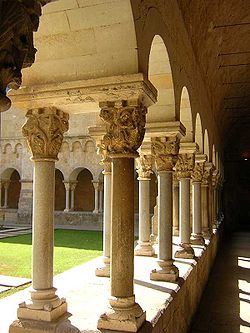- Monastery of Sant Cugat
-
The Monastery of Sant Cugat is a Benedictine abbey in Sant Cugat del Vallès, Catalonia, Spain. Founded in the 9th century, and built until the 14th century, it was the most important monastery in the county of Barcelona. It has its main feature in the large cloister, in Romanesque style.
Contents
History
The monastery's origin date back to the 9th century, when it was decided to unite the church (existing from the 5th century) housing the remains of St. Cucuphas (Catalan: Sant Cugat) to an annexed fortification. The monastery started to the expand its possessions from the 10th century onwards. In 985 it was damaged by an attack of Muslim troops led by al-Mansur Ibn Abi Aamir.
In the late 11th century, count Ramon Berenguer II of Barcelona decreed that the monastery would be subject to St Ponce de Tomieres, in Provence, creating turmoil amongst the monks of Sant Cugat. The abbot of St. Ponce moved to the Catalan monastery and the monks who disagreed with his administration were expelled. However, the bishop of Barcelona claimed his rights over the monastery, which was returned to the diocese of Barcelona. At the time Sant Cugat was controlling the monasteries of Santa Cecília de Montserrat, Sant Llorenç del Munt, Sant Pau del Camp, Sant Pere de Clará and Sant Salvador de Breda.
In the mid-12th century the construction of a new monastery was begun. It was finished in 1337. In 1350 the fortification works started. In this period, however, the monastery started to decline. The nomination of the abbot, previously belonging to the monks, was switched to the diocese. During the War of Spanish Succession, it was occupied by troops of Archduke Charles, causing damage to the structure. Restoration works were lated completed in 1789.
In 1835 the monastery was abandoned by the monks, remaining empty until 1851, when it was decided its restoration. It was declared a National Monument in 1931.
Overview
The main feature of the monastery is its cloister, a notable example of Romanesque art, dating to the 12th century. In the 16th century a second floor was added, as well as an atrium and the entrance.
With a length of more than 30 meters, the cloister was designed by Arnau Cadell and his disciple Lluís Samaranch. It has a square plan with semicircular arches, supported by pairs of columns. Each of the latter has a finely decorated capital, with various details ranging from animals to biblical scenes.
The church is instead in Gothic style. It has a nave and two aisles. The façade has a large (8.2 diameter) rose window, similar to those in the Cathedrals of Barcelona and of Tarragona. The church houses a Gothic altarpiece, known as the retablo de Todos los Santos, executed in 1375 by Pere Serra.
Sources
- Tomàs Bonell, Jordi (1994). Descobrir Catalunya. Barcelona: Premsa Catalana.
External links
Categories:- Romanesque architecture in Catalonia
- Gothic architecture in Catalonia
- Monasteries in Catalonia
- Religious organizations established in the 9th century
Wikimedia Foundation. 2010.


